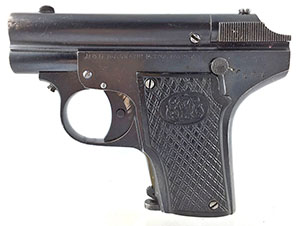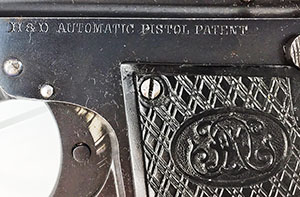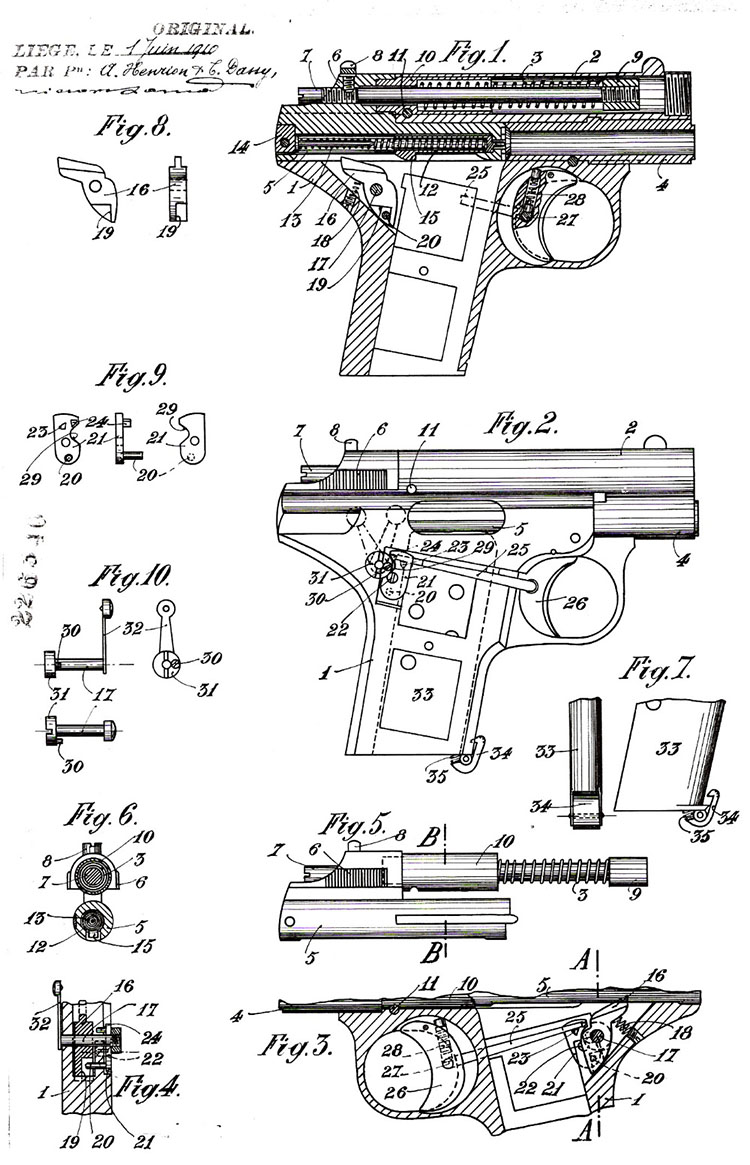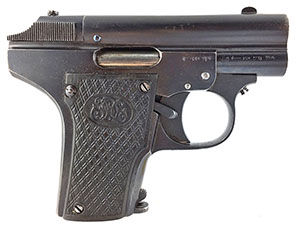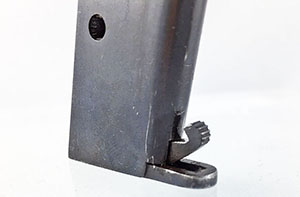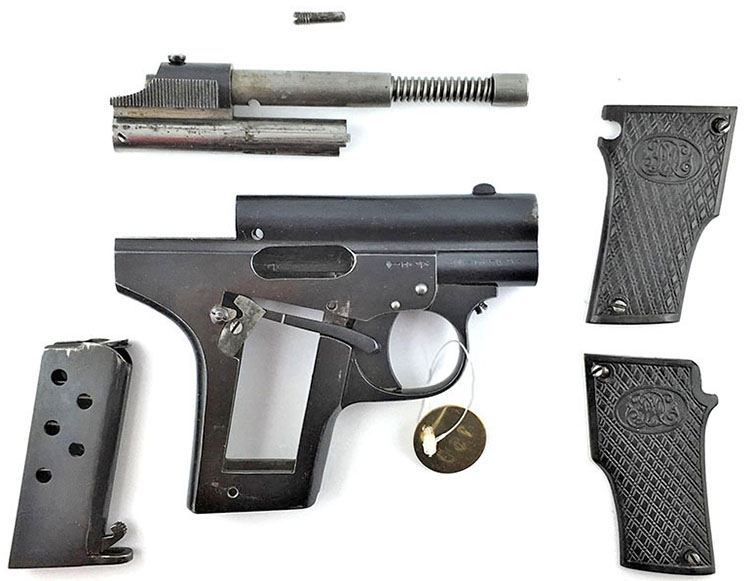 |
||||||||||||||||||||||||||||||||||||||||||||||||||||||||||||||||||||||||||||||||||||||||||||||||||||||||||||||||
|
Henrion & Dassy Automatic Pistol – by Dr. Stefan Klein
Armand Henrion and T. Dassy were Belgian gun manufacturers in Liege who were well known for their shotguns and high capacity revolvers from the 1890s to the 1930s. At some point, Victor Heuschen joined Henrion and Dassy to form the company Henrion, Dassy & Heuschen (HDH). Corporate names officially registered with the Belgian authorities include:
John Walter states that Heuschen joined the firm circa 1895, though there is no other evidence to support this. In any case, the gun in question is clearly marked H&D, and the monogram on the grip plates appears to have only a single H. The patent date is 1 June 1910, and the applicants are listed as “A. Henrion and T. Dassy, Fabricants d’Armes de Liege.” The H&D 6.35 mm Pistol The pistol is marked on the left side of the frame in all capital serif characters as follows: H & D AUTOMATIC PISTOL PATENT
The pistol has a fine blue finish. It weighs 465g, has a total length of 117mm, and a height of 91mm. The barrel length is 53 mm with a right-hand twist. The magazine holds six cartridges. I assume that not many of these pistols were made. In all the years I have been collecting vestpocket pistols I have only seen two of them. Belgian Patent 226340 According to a Spanish collector, the phrase H&D AUTOMATIQUE PISTOL PATENT was registered as a trade mark on 7 September 1910. The trade mark implies that there must have been a patent, which I was able to locate with the help of Alain Daubresse of www.littlegun.be. Belgian patent no. 226340 was filed on 1 June 1910 by A. Henrion and T. Dassy. Since the patent is our primary source of information about the pistol, this article will consist largely of a translation and explication of the patent. Throughout, I will refer to the numbers shown in the patent drawings.
Detailed Functional Description The HD pistol has three main components: the frame (1) with recoil spring housing (2) above the barrel [see Fig. 2], and the breech block with the attached recoil spring (3) [see Fig. 5]. The breech-block (5) is cylindrical and has an upper extension (6) with serrations for gripping, to which is connected the recoil spring guide rod (7), and the recoil spring itself (3). The breech block is guided in a crescent-shaped channel in the frame. The recoil spring guide rod is secured to the upper extension of the breech block (6) by a screw (8), which simultaneously forms the rear sight. The recoil spring rests against the rear of the recoil spring sleeve (10), which attaches to the frame of the pistol with a pin or screw (11). By removing the pin or screw the entire breech-block and recoil spring assembly can be removed to the rear. The breech block (5) contains the striker (12) and the striker spring (13), secured by a plug with a pin (14). [See Fig. 1]
The sear has a recess (19) into which the pin (20) of the sear release mechanism (21) engages. [See Figs. 8 and 9] By pressing the trigger (26), the connector bar (25) rotates the sear release mechanism counterclockwise. A spring tensioned pin (27) joins the connector bar to the trigger, and the spring (28) holds the connector bar in its original position in front of a notch (24) of the sear release mechanism. Lug 23 on the sear release mechanism (21) raises the end of the connector bar and disengages it from lug 24. A spring (18) forces the sear release mechanism back to its original position, so that the connector bar can re-engage lug 24 only after the trigger has been released. The safety lever acts on the sear release mechanism, which has a recess (29) for this purpose. The axis (17) of the safety lever has a head (31) with a pin (30) placed on one half of it. In the "S" (Safe) position, this pin engages in the recess of the sear release mechanism and blocks rotation about the axis (22). In position "F" (fire), the sear release mechanism can rotate freely. The lower front end of the magazine (33) has a spring tensioned curved lever (34) which engages in a recess in the frame. By pressing the lever the magazine unlocks and can be removed with one hand. 1. Unlocked breech automatic pistol, in which the recoil spring is supported by a guide rod connected to the breech block and fits in a tube which covers a certain length of the recoil spring and is fixed in the frame of the pistol using a pin, screw, or equivalent. The head of the recoil spring guide rod abuts the front edge of the tube when the breech block reaches the end of its recoil stroke toward the rear. [See Fig. 5] 2. Automatic pistol, according to claim 1, in which the guide rod of the recoil spring is attached to the breech block and secured with a screw, the head of the screw also forming the rear sight. 3. Automatic pistol, in which the sear is released by a sear release mechanism pivoting laterally in the frame. The release mechanism has two projecting pins, on which the connector bar acts when the trigger is pressed. [See Fig. 9]
5. Automatic pistol according to claim 4, wherein the axis of the safety, which carries the eccentric stop, also constitutes the pivot axis of the sear. 6. Automatic pistol in which the connector bar has a flattened pin on its end which is tensioned by a spring, the other end of which rests in the frame, so as to serve simultaneously as a spring for the sear and the sear release mechanism. 7. Automatic pistol, in which the spring of the sear is housed in a perforation passing through the rear wall of the frame, so that it can be put in place and removed from the outside [and is therefor accessible from the outside for cleaning and maintenance purposes]. 8. Automatic pistol, in which the magazine release is formed of a curved lever that rotates around an axis at the bottom of the magazine. The upper part of the lever ends in a hooked head that engages with the frame and is under spring pressure. This spring pressure allows removal of the magazine with one hand.
Field Stripping
|
||||||||||||||||||||||||||||||||||||||||||||||||||||||||||||||||||||||||||||||||||||||||||||||||||||||||||||||||
|
||||||||||||||||||||||||||||||||||||||||||||||||||||||||||||||||||||||||||||||||||||||||||||||||||||||||||||||||
|
Copyright 2019 by Stefan Klein. All rights reserved. |
||||||||||||||||||||||||||||||||||||||||||||||||||||||||||||||||||||||||||||||||||||||||||||||||||||||||||||||||
|
|
||||||||||||||||||||||||||||||||||||||||||||||||||||||||||||||||||||||||||||||||||||||||||||||||||||||||||||||||
